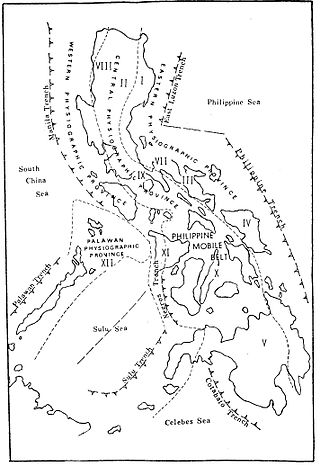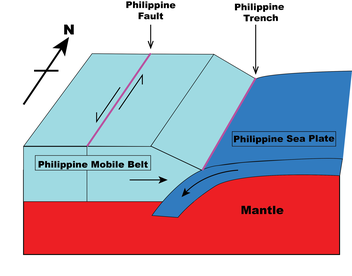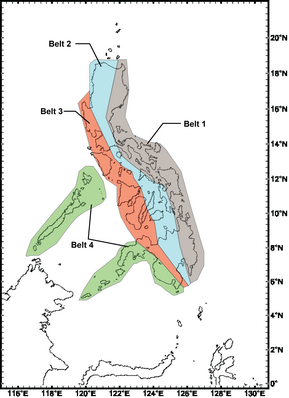Obduction is a geological process whereby denser oceanic crust is scraped off a descending ocean plate at a convergent plate boundary and thrust on top of an adjacent plate. When oceanic and continental plates converge, normally the denser oceanic crust sinks under the continental crust in the process of subduction. Obduction, which is less common, normally occurs in plate collisions at orogenic belts or back-arc basins.

The Manila Trench is an oceanic trench in the Pacific Ocean, located west of the islands of Luzon and Mindoro in the Philippines. The trench reaches a depth of about 5,400 metres (17,700 ft), in contrast with the average depth of the South China Sea of about 1,500 metres (4,900 ft). It is created by subduction, in which the Sunda Plate is subducting under the Philippine Mobile Belt, producing this almost N-S trending trench. The convergent boundary is terminated to the north by the Taiwan collision zone, and to the south by the Mindoro terrane. It is an area pervaded by negative gravity anomalies.

The Sunda Plate is a minor tectonic plate straddling the Equator in the Eastern Hemisphere on which the majority of Southeast Asia is located.

The Philippine Trench is a submarine trench to the east of the Philippines. The trench is located in the Philippine sea of the western North Pacific Ocean and continues NNW-SSE. It has a length of approximately 1,320 kilometres and a width of about 30 km (19 mi) from the center of the Philippine island of Luzon trending southeast to the northern Maluku island of Halmahera in Indonesia. At its deepest point, the trench reaches 10,540 meters.

In the geology of the Philippines, the Philippine Mobile Belt is a complex portion of the tectonic boundary between the Eurasian Plate and the Philippine Sea Plate, comprising most of the country of the Philippines. It includes two subduction zones, the Manila Trench to the west and the Philippine Trench to the east, as well as the Philippine Fault System. Within the Belt, a number of crustal blocks or microplates which have been shorn off the adjoining major plates are undergoing massive deformation.
The Philippine Rise, formerly known as Benham Rise, is an extinct volcanic ridge located in the Philippine Sea approximately 250 kilometers (160 mi) east of the northern coastline of Dinapigue, Isabela. The rise has been known to the people of Catanduanes as Kalipung-awan as early as the precolonial era of the Philippines, which literally means "loneliness from an isolated place".
The Philippine Fault System is a major inter-related system of geological faults throughout the whole of the Philippine Archipelago, primarily caused by tectonic forces compressing the Philippines into what geophysicists call the Philippine Mobile Belt. Some notable Philippine faults include the Guinayangan, Masbate and Leyte faults.

The island of Taiwan was formed approximately 4 to 5 million years ago at a convergent boundary between the Philippine Sea Plate and the Eurasian Plate. In a boundary running the length of the island and continuing southwards, the Eurasian Plate is sliding under the Philippine Sea Plate. In the northeast of the island, the Philippine Sea Plate slides under the Eurasian Plate. Most of the island comprises a huge fault block tilted to the west.

The Luzon Volcanic Arc is a chain of volcanoes in a north–south line across the Luzon Strait from Taiwan to Luzon. The name "Luzon Volcanic Arc" was first proposed by Carl Bowin et al. to describe a series of Miocene to recent volcanoes due to eastward subduction along the Manila Trench for approximately 1,200 km from the Coastal Range in Taiwan south to southern Mindoro in the Philippines. Islands that form part of the arc are the Eastern Coastal Range of Taiwan, Green Island, Taiwan, Orchid Island, Kaotai Rock, Mavudis or Y'ami Island, Mabudis, Siayan Island, Itbayat Island, Diogo Island, Batan Island, Unnamed volcano Ibuhos, Sabtang Island, Babuyan, Didicas, and Camiguin de Babuyanes. At the south end it terminates on Luzon. The geochemistry of a number of volcanoes along the arc have been measured. There are five distinct geochemical domains within the arc. The geochemistry of the segments verified that the volcanoes are all subduction related. Isotopes and trace elements show unique geochemical characteristics in the north. Geochemical variations northward were due to the subduction of sediments derived from the erosion of continental crust from China and Taiwan.
The South China Sea Basin is one of the largest marginal basins in Asia. South China Sea is located to the east of Vietnam, west of Philippines and the Luzon Strait, and north of Borneo. Tectonically, it is surrounded by the Indochina Block on the west, Philippine Sea Plate on the east, Yangtze Block to the north. A subduction boundary exists between the Philippine Sea Plate and the Asian Plate. The formation of the South China Sea Basin was closely related with the collision between the Indian Plate and Eurasian Plates. The collision thickened the continental crust and changed the elevation of the topography from the Himalayan orogenic zone to the South China Sea, especially around the Tibetan Plateau. The location of the South China Sea makes it a product of several tectonic events. All the plates around the South China Sea Basin underwent clockwise rotation, subduction and experienced an extrusion process from the early Cenozoic to the Late Miocene.
The 2017 Surigao earthquake occurred on February 10, 2017, at 10:03 PM (PST), with a surface wave magnitude of 6.7 off the coast of Surigao del Norte in the Philippines. According to the PHIVOLCS Earthquake Intensity Scale the earthquake was an Intensity VII (Destructive) earthquake at maximum. In the past Surigao province has been hit by a magnitude 7.2 tremor in both 1879 and 1893.
The Cotabato Trench is an oceanic trench in the Pacific Ocean, off the southwestern coast of Mindanao in the Philippines. Along this trench the oceanic crust of the Sunda Plate beneath the Celebes Sea is being subducted beneath the Philippines Mobile Belt. It forms part of a linked set of trenches along the western side of the Philippines formed over east-dipping subduction zones, including the Manila Trench and the Negros Trench. At its northern end the rate of convergence across this boundary is about 100 mm per year. It is a relatively young structure, forming during the late Miocene to Pliocene. This age is consistent with the estimated age of the sedimentary rocks in the accretionary wedge associated with the trench and the age of adakitic arc rocks on Mindanao thought to date the onset of subduction.
The 1879 Surigao earthquake occurred on June 30 at 18:38 02:55 local time on the northeastern tip of Mindanao. The earthquake with a moment magnitude (Mw ) of 7.4 struck with an epicenter just south of Lake Mainit. Extensive damage occurred but there were no reports of casualties.

The Sulu Trench is an oceanic trench in the Pacific Ocean, located west of the islands of Mindanao and Sulu in the Philippines. The trench reaches a depth of about 5,600 metres (18,400 ft), in contrast with the average depth of the South China Sea of about 1,500 metres (4,900 ft). The trench formed when the Sunda Plate subducted below the Philippine Mobile Belt. The convergent boundary terminates at the Negros Trench in the east.

The Negros Trench is an oceanic trench located northeast of the Sulu Trench and west of Negros Island Region in Visayas, the trench is located in the Sunda Plate in the southwestern region of the Pacific Ocean. The depth of the Negros Trench is unknown, in contrast it's neighboring trench the Sulu Trench has a depth of 5,600. During the Early-Miocine, the Sunda Plate subducted below the Philippine Mobile Belt, which would later form the Negros Trench.

The East Luzon Trough is an oceanic trench north of the Philippine Trench and east of the island of Luzon. The trench is located near the Philippine orogeny and located in the southeastern region of the Philippine Sea Plate. The depth of the trough is 5,700 meters. The East Luzon Trough formed during the Eocene and Oligocene epoch, 40–24 million years ago.
The North Luzon Trough is a major geological feature located off the northern coast of Luzon Island between the Manila Trench and the Vigan-Agao Fault in the Philippines. It is a well-developed forearc basin formed in front of the Luzon Volcanic Arc, an island arc system. The trough is a result of the active subduction of the Philippine Sea Plate beneath the Eurasian Plate.
The Mindoro Suture Zone is a major geological feature located in the Philippines, separating the Mindoro Block from the North Palawan Block. It is a suture zone, which is a linear belt of rock that marks the boundary between two tectonic plates that have collided. The Mindoro Suture Zone is a complex zone of deformation that includes a variety of rock types, including mafic and ultramafic rocks, amphibolites, and metasediments.













